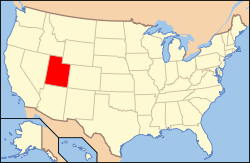Orderville, Utah
| Orderville | |
|---|---|
| Town | |

Orderville museum of the Daughters of Utah Pioneers
|
|
 Location in Kane County and the state of Utah |
|
 Location of Utah in the United States |
|
| Coordinates: 37°15′44″N 112°39′12″W / 37.26222°N 112.65333°WCoordinates: 37°15′44″N 112°39′12″W / 37.26222°N 112.65333°W | |
| Country | United States |
| State | Utah |
| County | Kane |
| Founded | 1875 |
| Incorporated | 1934 |
| Named for | United Order |
| Area | |
| • Total | 9.2 sq mi (23.8 km2) |
| • Land | 9.2 sq mi (23.8 km2) |
| Elevation | 5,449 ft (1,661 m) |
| Population (2012) | |
| • Total | 576 |
| • Density | 63/sq mi (24/km2) |
| Time zone | Mountain (MST) (UTC-7) |
| • Summer (DST) | MDT (UTC-6) |
| ZIP code | 84758 |
| Area code(s) | 435 |
| FIPS code | 49-57080 |
| GNIS feature ID | 1431023 |
Orderville is a town in Kane County, Utah, United States. The population was 596 at the 2000 census. The town was founded and operated under the United Order of The Church of Jesus Christ of Latter-day Saints. This system allowed the community to flourish for some time, but ultimately ended in 1885.
Orderville was established at the direction of LDS Church president Brigham Young in 1875 specifically to live United Order, a voluntary form of communalism defined by Joseph Smith. Orderville was settled primarily by destitute refugees from failed settlements on the Muddy River in Nevada. When it was settled, Orderville included 335 acres of land, and contained 18 houses, 19 oxen, 103 cows, 43 horses, 500 sheep, 30 hogs, 400 chickens, and 30,000 feet of lumber. The settlement began completely debt free.
Homes were one- or two-room apartment units arranged around the town square. Community dining halls and public buildings were constructed. The dining hall began operation for the town on July 24, 1875 and prepared meals for more than 80 families. Men ate first, followed by women and children. Meal times were scheduled at 7 am, 12 pm, and 6 pm.
Under the United Order, no person in Orderville could have private property, as it was all considered to be God's land. Each person was made a steward over some personal effects, and every family a steward over a home. During the first two years, the settlers worked without receiving income. They were allowed to use supplies and take food as needed. The bishop of Orderville oversaw the distribution of goods. Credit were recorded for all work done by men, women, and children and used to obtain needed materials and keep track of the labor done in the settlement. In 1877, the Order began a price system to replace the credit system, and monetary values were assigned to all labor and goods. At the beginning of each year, debts were forgiven, and those who had earned a surplus voluntarily gave it back to the Order.
...
Wikipedia
